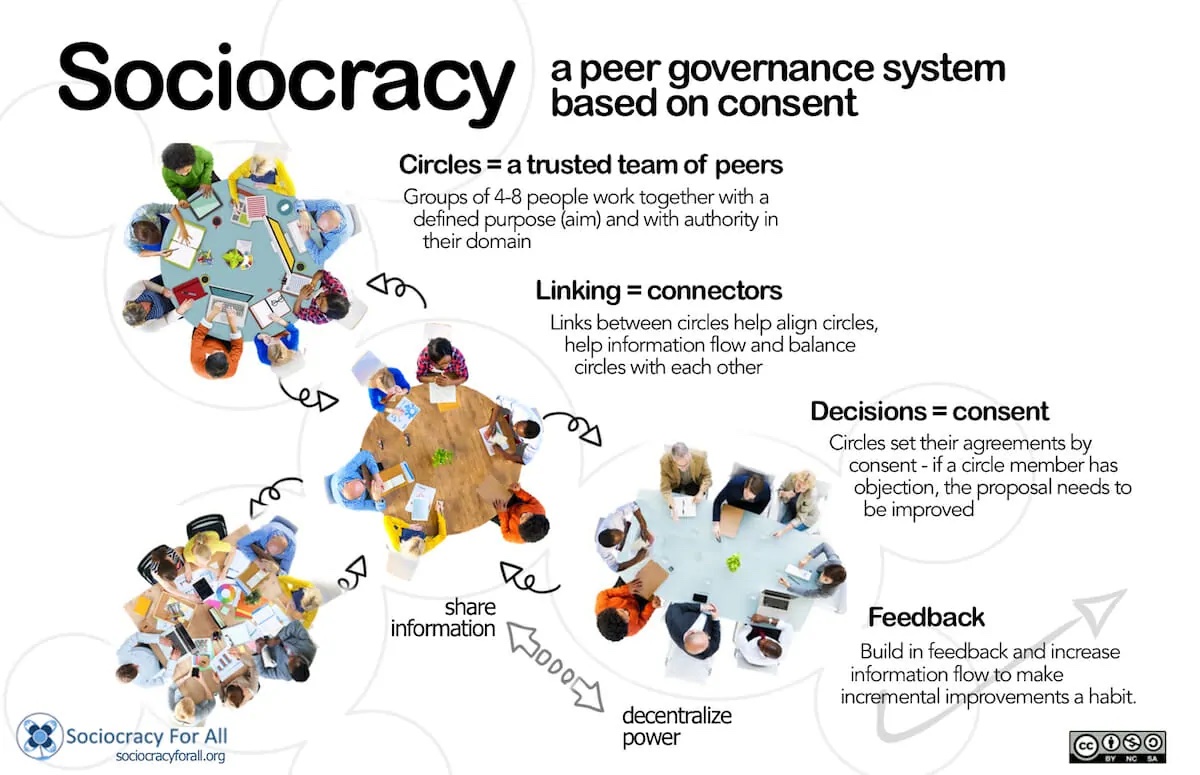Alternative Governance

Summary
For many communities around the world, faith in their government and governing processes is absent. In the face of this, and in pursuit of good order and working relationships, there exists a diverse range of alternative governance arrangements. On the one hand we see new governing systems such as the blockchain emerge, while on the other we see the resurgence of “traditional” or customary forms of governance. This summary will outline the alternative governance methods of sociocracy and distributed governance.
Sociocracy
Sociocracy is a system of governance based upon consent decision making as opposed to majority voting. The aim is that this method of governing will achieve solutions that create harmonious social environments as well as productive organizations and businesses.
What we call sociocracy now was first developed as the Sociocratic Circle Method (SCM) by Gerard Endenburg in the Netherlands in the 1980s. The SCM method is a recent instantiation of an approach first developed by Beatrice Cadbury and Kees Boeke in the mid-20th century.
Distributed Governance
Distributed governance (DGov) is a form of organization where there is no centralized actor or hierarchy – all participants are treated equally. In the blockchain context, distributed governance refers to the administration of decision-making processes like voting through blockchains. Within these DGov organizations, actors interact with each other according to protocols built into the code of the organization on the blockchain.
History and Central Ideas
Sociocracy
The term sociocracy was coined by French philosopher Auguste Comte in 1851 as a parallel to sociology, the science that studies how people organize themselves into social systems. Comte held that a government led by sociologists would use scientific methods to meet the needs of all the people, not just the ruling class.
American sociologist Lester Frank Ward was an active advocate of a sociocracy to replace the system of majority vote and the political competition it encouraged. Ward expanded the concept of sociocracy in Dynamic Sociology (1883) and The Psychic Factors of Civilization (1892). Ward believed that a well educated public was essential for effective governance. He advocated for a more effective, dispassionate, and scientific discussion of issues and problems in the place of the emotional and partisan nature of contemporary politics.
Peace activists and married couple Kees Boeke and Beatrice Cadbury expanded Ward's ideas in the mid-20th century and implemented the first sociocratic organizational structure in a school in Bilthoven, the Netherlands. Boeke used a method of consensus decision making based on the practices of the Quakers, which he described as one of the first sociocratic organizations.
Boeke defined three "fundamental rules":
(1) The interests of all members must be considered and the individual must respect the interests of the whole;
(2) No action could be taken without a solution that everyone could accept; and
(3) All members must accept these decisions when unanimously made. If a group could not make a decision, the decision would be made by a "higher level" of representatives chosen by each group.
For the process to be effective, members of each group must trust each other, and it is claimed that this trust will be built over time as long as this method of decision making is used.
In the late 1960s and early 1970s Gerard Endenburg, a former student of Boeke's, further developed and applied Boeke's principles in his electrical engineering company. Endenburg wanted to replicate the cooperation and harmony he had experienced in Boeke's school in a business environment. He recognized, however, that in industrial production with a diverse and changing workforce, he could not wait for workers to trust each other before they could make decisions. Integrating his understanding of physics, cybernetics, and systems thinking, Endenburg developed the Sociocratic Circle Organizing Method.
The Sociocratic Circle Organizing Method is based on a "circular causal feedback process". It uses a hierarchy of circles corresponding to units or departments of an organization. The hierarchy involved is a circular hierarchy – the links between circles combine to form feedback loops up and down the organization.

Credit: Sociocracy For All
Circles make policy decisions by consent. There is consent to a proposal when no member of the circle has an objection. Objecting requires that a circle member has reason to assume that the circle cannot achieve its aim adequately if the circle approves the proposal.
Many intentional communities (such as some cohousing communities and ecovillages) use sociocracy, as well as some nonprofits and cooperative workplaces. Its principles have a resemblance to permaculture and cooperative principles as well as Agile practices.
Distributed Governance
Distributed governance is a method of forming consensus and legitimating decisions without the need for a central actor or hierarchy.
In traditional hierarchical organizations, there is always some level of human authority required to manage and protect organizational processes. For example, democratic groups need to trust that their secretaries will count the votes properly and democratic states need police to remove individuals who break the social contract. When such responsibilities sit with people, trust is necessarily required. And humans are fallible.
DGov offers a solution by allowing these decision-making processes to be governed by code, not humans.
If we see companies fundamentally as complex networks of contracts, then they are able to be stored on a blockchain. The earliest example of this is The DAO, an online venture capital fund. The DAO sought to allocate funds to projects in the fairest way possible, without funds getting misdirected to personal connections. 18,000 stakeholders held voting rights to allocate funds to certain projects. While The DAO did suffer a high-profile hack, the platform nonetheless proved the possibility of running a truly stateless, non-physical organization that controlled a very large amount of money without centralized human leaders.
Proponents of distributed governance argue that this method of governance supports faster learning and helps an organization to evolve in the long run. It is also argued it is a more efficient way of governance: usually, a decision needs to pass many levels of the hierarchy, meanwhile the opportunity window can be lost or the cost of that decision can exceed its value. In addition, those impacted by the decision in question tend to have the best grasp on the issue. It is therefore more suitable that these individuals be involved in the decision-making process, as opposed to actors higher up in the organization's hierarchy and therefore more distanced from the issue at hand. The absence of human error is also a popular argument; code is not susceptible to bribery or persuasion.
Key Actors and Organizations
- Auguste Comte: considered to be the first philosopher of science. Coined the term ‘sociocracy’.
- Lester Frank Ward: American sociologist and sociocracy advocate.
- Beatrice Cadbury and Kees Boeke: expanded Ward's ideas and implemented the first sociocratic organizational structure in a school.
- Gerard Endenburg: electrical engineer and former student of Boeke's. Developed the Sociocratic Circle Organizing Method.
- The Sociocratisch Centrum (Sociocratic Center) in Rotterdam: founded by Endenburg and his colleague Annewiek Reijmer in the 1980s.
Key Texts
- Ward, L. F. 1881. Politico-social Functions. Penn Monthly. University Press Co. 12: 321–336.
- Ward, L. F. Dynamic Sociology. New York: D. Appleton and Company, 1883.
- Ward, L. F. The Psychic Factors of Civilization. Ginn and Company, 1892.
References
- Rau, T. Sociocracy – basic concepts and principles. Sociocracy For All. No date. https://www.sociocracyforall.org/sociocracy/
- Semenchuck, M. What is Distributed Governance? DGOV Foundation Blog, 2018. https://medium.com/dgov/what-is-distributed-governance-3b103eb082c0
- Vitalik, B. DAOs, DACs, DAs and More: An Incomplete Terminology Guide. Ethereum Foundation Blog, 2014 https://blog.ethereum.org/2014/05/06/daos-dacs-das-and-more-an-incomplete-terminology-guide/
Further Reading
- Rau, T.J. and Koch-Gonzalez, J. (2018) ‘Many Voices One Song: Shared Power with Sociocracy’, Sociocracy For All.
- Reyes, C.L. et al. Distributed Governance. William and Mary Law Review Online: Vol 59, Article 1. 2017 https://scholarship.law.wm.edu/cgi/viewcontent.cgi?article=1003&context=wmlronline